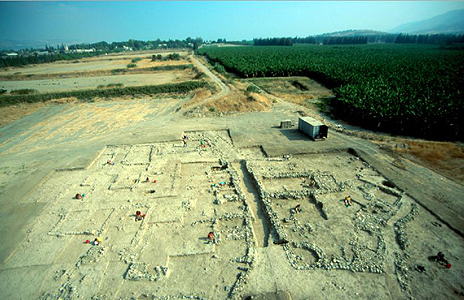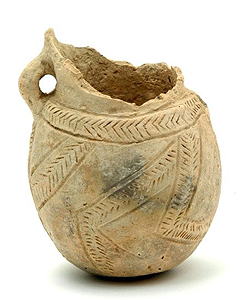
Sha'ar HaGolan


Prehistoric Israel's first culture, the Yarmouk, founded the village of Shar'ar HaGolan in the Pottery Neolithic A (PNA), c. 6400-6000 BCE, is located central Jordan Valley on the northern bank of the Yarmouk River. The Yamoukian culture was one of the oldest in the Southern Levant and one of the first to make use of pottery.
Sha'ar HaGolan was a permanent village composed of very large courtyard houses ranging in area between 250 and 700 m² (2700 ft² and 7500 ft²). The houses consist of central courtyards surrounded by small living, work, and storage rooms. This is significant in the history or the architecture of ancestors, because this site is the first appearance of the courtyard house — the prototypical traditional house type of all Mediterranean societies. Houses had both circular and rectangular rooms. Extended families apparently occupied these monumentally scales houses was the result of population growth pressure of the age.
A hierarchical matrix of pedestrian movement composed of pebble-paved streets, some 3 m. (10 ft.), and narrow winding alleys 1 m (3 ft.) wide passing between the houses is evidence of sophisticated community planning, and are the earliest streets found in Israel, and among the earliest streets anywhere.
Three levels of social organization and site planning are evidenced at Sha'ar HaGolan:
1. Individual households
2. Extended family compounds
3. Village community
Elevation is 200 m. (656 ft.) above sea level.
Construction materials: walls of loaf-shaped mud bricks, on fieldstone masonry foundations, with roofs of straw-stabilized mud over wood beams and purlins.
Source of data for CG model:
1. Garfinkel, Yosef, The Hebrew University of Jerusalem, 2006; The Social Organization at Neolithic Sha'ar Hagolan The Nuclear Family, the Extended Family & the Community, in Banning, E.B. and Chazan, Michael (editors), Domesticationg Space, Construction, Community, and Cosmology in the Late Prehistoric Near East, Studies in Early Near Eastern Production, Subsistence, and Environment 6, 2006, Berlin, exoriente (2006).
https://www.exoriente.org/docs/00075.pdf
2. Banning, E. B. 2003; Housing Neolithic Farmers, Near Eastern Archaeology, Mar-Jun 2003; ProQuest.
https://www.researchgate.net/publication/266393614_Housing_Neolithic_Farmers



